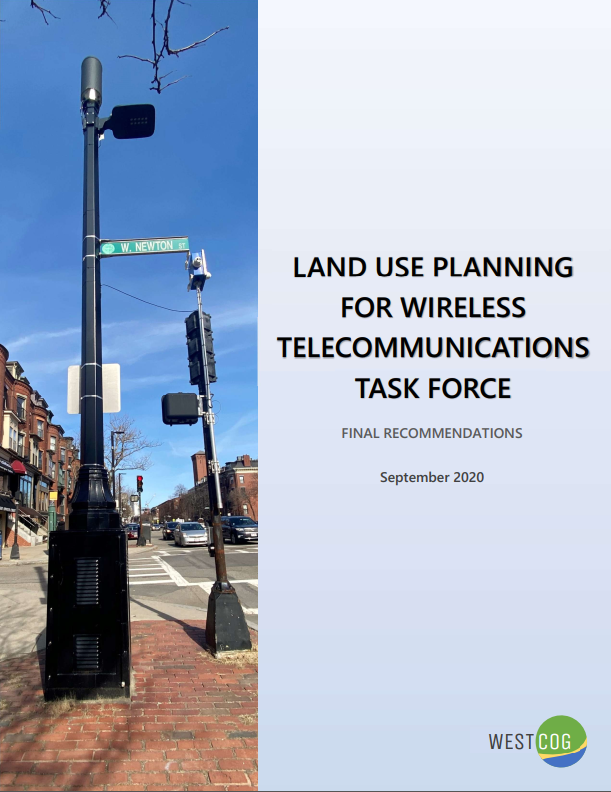LAND USE PLANNING FOR WIRELESS TELECOMMUNICATIONS TASK FORCE
The strength of the nation’s economy is directly linked to the speed of broadband services as local governments, businesses, industries, educational institutions and American citizens increasingly rely on fast download and upload capabilities for their mobile devices and for a wide range of services associated with the Internet of Things. Our greater reliance on mobile communication services also underscores the need for a regional strategy that not only facilitates improved data capacity transmission but protects the region’s community character. Municipal regulations and policies are needed to address these important economic development and community character issues.
Mission Statement
The Land Use Planning for Wireless Telecommunications Task Force will create a coordinated development strategy to best serve the citizens and businesses of Western Connecticut. It will work within the authority of municipalities towards making Western Connecticut a digital leader while preserving the unique character of its communities by undertaking the following tasks:
- Make recommendations for revisions to the municipal permitting procedures that comply with FCC requirements
- Create model ordinances and explore other management strategies for wireless telecommunication facilities
- Identify priority zones for wireless telecommunication facilities
The Task Force is made up of appointed municipal staff.
Recommendations Report
See the Land Use Planning for Wireless Telecommunications Task Force’s Final Recommendations Report.

Webinar: Municipal Strategies for Regulating Small Cell Wireless Facilities (12/1/2020)
FAQ
- Who is in charge of regulating radio frequency exposure?
- I am concerned about the potential health effects of 5G equipment, can my municipality deny the application?
- Who can I contact to express my concern about the potential health effects of 5G?
- Who has jurisdiction over the siting of 5G and other wireless telecommunications facilities in Connecticut?
- What is the purpose of the Task Force?
1. “Who is in charge of regulating radio frequency exposure?”
The Federal Communications Commission (FCC) is tasked with setting radio frequency exposure limits for the whole country. The FCC is overseen by the United States Congress. WestCOG has prepared a Summary of agencies involved in regulating or guiding radio frequency exposure.
2. “I am concerned about the potential health effects of 5G equipment, can my municipality deny the application?”
Municipalities cannot deny applications for 5G installments based on health concerns- as long as they comply with FCC radio-frequency exposure standards. Under federal law, states and municipalities “shall not prohibit or have the effect of prohibiting the provision of personal wireless services” (47 U.S.C. § 332(c)(7)(B)(i)). Furthermore, “no state or local government or instrumentality thereof may regulate the placement, construction, and modification of personal wireless service facilities on the basis of the environmental effects of radio frequency emissions to the extent that such facilities comply with the Commission’s regulations concerning such emissions.” (47 U.S.C. § 332(c)(7)(B)(iv)).
3. Who can I contact to express my concern about the potential health effects of 5G?”
The public health and safety of wireless telecommunications equipment is regulated by the United States Congress through the following agencies:
FDA. The Food and Drug Administration (FDA) is responsible for the collection and analysis of scientific data relating to the safety of electronic devices, including cellphones (21 U.S.C. 1010). Their team of doctors, scientists and engineers review the latest publications and report their findings to the FCC. You can also contact the Center for Devices and Radiological Health at DICE@fda.hhs.gov.
FCC. The FCC sets the radio frequency exposure standards and establishes mitigation methods (47 U.S.C 1.1310). You can also contact the FCC at rfsafety@fcc.gov.
Congressional Rep. You can also contact your congressional representatives to express your concerns.
4. “Who has jurisdiction over the siting of 5G and other wireless telecommunications facilities in Connecticut?
In Connecticut, jurisdiction over siting is complex and depends on the location, attachment style and height of the proposed facility. For example, the Public Utilities Regulatory Authority (PURA) has authority over small wireless facilities (SWF) on electric distribution lines and poles. If the associated equipment is placed in the local right-of-way, the municipality also has authority over the associated equipment placed in the public right-of-way. However, state and local jurisdictions in Connecticut are limited to those authorities delegated by the FCC. WestCOG has prepared a summary of the various jurisdictional scenarios in Connecticut.
5. “What is the purpose of the Task Force?”
In the past, wireless telecommunications were solely provided using tall towers that largely fell within the purview of the Connecticut Siting Council. Moving forward, mobile broadband providers are looking for ways to best meet the public’s demand for more data capacity. This will be achieved by installing “small cell antennas” in closer proximity to high density living and working environments on structures such as billboards, chimneys, gas station or hotel signs, decorative poles, and the sides or roofs of buildings. This drastic change in the telecommunication siting arena brings municipalities to the jurisdictional forefront for SWF sitings. Additionally, the October 2018 FCC regulations expanded previous “shot clock” standards designed to expedite the review and approval of SWF across the nation by limiting the time required to review and approve these projects to 60 days for individual proposals on existing poles or other structures and 90 days for new locations and for batch proposals. The purpose of the Task Force is to address these developments by recommending revisions to municipal regulations that address both community character, traffic safety and public safety concerns and to set up procedures for reviewing applications. This is all within the municipality’s purview, as long as a municipality’s regulations do not prohibit the installation of these facilities and comply with FCC requirements for objective design standards.
Task Force Developments
- 5G Municipal Strategies Presentation. 3/2/2020: A summary of strategies for municipalities to consider as 5G deployment become more of a reality in the region.”
- Draft Model Municipal Ordinance Presentation. 4/20/2020: The task force met to discuss a Draft Model Municipal Ordinance. The presentation summarizes the elements being considered for the model ordinance.
- Memo: Scope of Municipal Authority over SWF. 5/8/2020: WestCOG created this memo to summarize who has jurisdiction over siting small wireless facilities in Connecticut.
- Model Municipal Ordinance for Wireless Telecommunications Facilities. 6/26/2020: The task force drafted a model municipal ordinance for municipalities to use as they consider implementing a town/city-wide policy for handling the application review, licensing, staffing and design of wireless telecommunications facilities. The model is based off of the Telecommunications Ordinance from Fairfax, California’s Municipal Code and was modified to address the concerns of the task force. Further recommendations will be released as the task force progresses.
- Municipal Gains Memo 11/16/2020: As a follow-up to our Land Use Planning for Wireless Telecommunications Task Force report issued in September 2020, this memo discusses some of the challenges that municipalities will face in attempting to exercise the use of the municipal gain function to expand telecommunication services.

